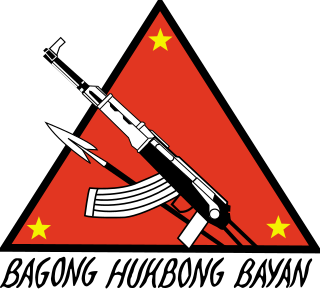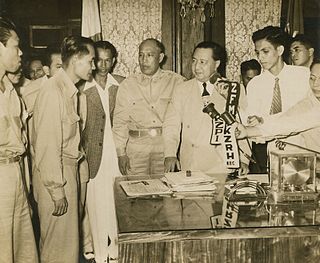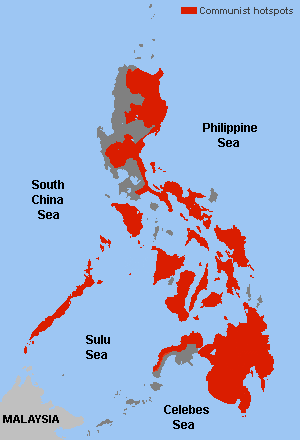
Luis Mangalus Taruc was a Filipino political figure and rebel during the agrarian unrest of the 1930s until the end of the Cold War. He was the leader of the Hukbalahap group between 1942 and 1950. His involvement with the movement came after his initiation to the problems of agrarian Filipinos when he was a student in the early 1930s. During World War II, Taruc led the Hukbalahap in guerrilla operations against the Japanese occupants of the Philippines.

The New People's Army, abbreviated NPA or BHB, is the armed wing of the Communist Party of the Philippines (CPP). It acts as the CPP's principal organization, aiming to consolidate political power from what it sees as the present "bourgeois reactionary puppet government" and to aid in the "people's democratic revolution". Founded on March 29, 1969, by the collaboration of Jose Maria Sison and former members of the Hukbalahap led by Bernabe Buscayno, the NPA has since waged a guerrilla war based on the Maoist strategy of protracted people's war. The NPA is one of the key figures in the ongoing Communist rebellion in the Philippines, the longest ongoing conflict in the country.

The Hukbong Bayan Laban sa Hapon, better known by the acronym Hukbalahap, was a Filipino communist guerrilla movement formed by the farmers of Central Luzon. They were originally formed to fight the Japanese, but extended their fight into a rebellion against the Philippine government, known as the Hukbalahap Rebellion, in 1946. It was put down through a series of reforms and military victories by Defense Secretary, and later President, Ramon Magsaysay.

The Communist Party of the Philippines (CPP) is a far-left, Marxist–Leninist–Maoist revolutionary organization and communist party in the Philippines, formed by Jose Maria Sison on 26 December 1968. It is designated as a terrorist group by the United States Department of State together with Sison and its armed wing New People's Army (NPA) in 2002. The European Union renewed its terrorist designation on the organization in 2019, though a 2009 ruling by the EU's second highest court delisted Sison as a "person supporting terrorism" and reversed a decision by member governments to freeze assets. According to the US' Central Intelligence Agency (CIA) World Factbook, the CPP and the NPA aims to destabilize the Philippines' economy and overthrow the national government.

Jose Maria Canlas Sison, also known as Joma, was a Filipino writer, poet, and activist who founded and led the Communist Party of the Philippines (CPP) and added elements of Maoism to its philosophy—which would be known as National Democracy. His ideology was formed by applying Marxism–Leninism–Maoism to the history and circumstances of the Philippines.
Crisanto Abaño Evangelista was a Filipino communist politician and labor leader of the first half of the 20th century. He is credited as being one of the founders of the Partido Komunista ng Pilipinas. Evangelista was also an influential head of the Congreso Obrero de Filipinas, at the time the foremost and largest trade federation in the Philippines, having served as secretary for multiple years. He also headed the Union de Impresores de Filipinas as its Secretary-General. Prior to forming the PKP, Evangelista was a member of the Partido Obrero de Filipinas, a Filipino workers' party with increasingly radical leanings. Evangelista was eventually captured by the Japanese during the Second World War and executed.

Pedro Abad Santos y Basco was a Filipino Marxist politician. He founded the Partido Sosyalista ng Pilipinas (PSP) or Philippine Socialist Party in 1932. He ran for several local elections but never won. He also ran for president in the 1941 Philippine presidential election, but later withdrew, weeks before the election. Luis Taruc of the Hukbalahap Rebellion was under his tutelage and was his right-hand man.

The Partido Komunista ng Pilipinas-1930 (PKP-1930), also known as the Philippine Communist Party, is a communist party in the Philippines that was established on November 7, 1930. It uses the aforementioned appellation in order to distinguish itself from its better known splinter group, the Communist Party of the Philippines.

The Revolutionary Workers' Party of the Philippines is a communist party that split from the Communist Party of the Philippines during the Second Great Rectification Movement.

The Hukbalahap Rebellion was a rebellion staged by former Hukbalahap or Hukbong Bayan Laban sa Hapon soldiers against the Philippine government. It started in 1942 during the Japanese occupation of the Philippines, continued during the presidency of Manuel Roxas, and ended in 1954 under the presidency of Ramon Magsaysay.

The New People's Army rebellion is an ongoing conflict between the government of the Philippines and the New People's Army (NPA), which is the armed wing of the Marxist–Leninist–Maoist Communist Party of the Philippines (CPP). It is the world's longest ongoing communist insurgency, and is the largest, most prominent communist armed conflict in the Philippines, seeing more than 43,000 insurgency-related fatalities between 1969 and 2008. Because the National Democratic Front of the Philippines (NDFP) which is the legal wing of the CPP, is often associated with the conflict, it is often also called the CPP-NPA-NDF conflict, or simply the C/N/N conflict, especially in the context of peace talks with the Philippine government.
Guillermo Capadocia (1909–1951) was a Filipino communist politician and labour leader. He was a prominent leader of the Communist Party in the Philippines (PKP) and different labour movements. During the last one and a half years of his life he was a regional guerrilla commander of the Hukbalahap.

The history of communist armed conflicts in the Philippines is closely related to the history of Communism in the Philippines, with various armed conflict linked to the armed wings of the various communist organizations that have evolved since 1930. The two largest conflicts have been the Hukbalahap Rebellion of 1942–1954, and the ongoing rebellion of the New People's Army, which began in 1969 under the auspices of the Communist Party of the Philippines (CPP). But various splinter groups have since separated from the CPP and have had a history of armed conflict with the Philippine government since then.
Communism in the Philippines emerged in the first half of the 20th century during the American Colonial Era of the Philippines. Communist movements originated in labor unions and peasant groups. The communist movement has had multiple periods of popularity and relevance to the national affairs of the country, most notably during the Second World War and the Martial Law Era of the Philippines. Currently the communist movement is underground and considered an insurgent movement by the Armed Forces of the Philippines.

Kabataang Makabayan, also known by the acronym KM, is an underground communist youth organization in the Philippines which was active from 1964 to 1975. It was banned by the Philippine government in 1972 when then-President Ferdinand Marcos declared martial law, and was driven underground. It was dissolved in 1975 along with other National Democratic mass organizations, as part of the National Democratic movement's change of strategy against the Marcos regime. Revived within the Manila-Rizal area in 1977 and later nationally in 1984, the organization continues to exist.
Juan Feleo was a Filipino peasant leader and politician. He was one of the founders of one of the Philippines' leading peasant groups, the Kalipunang Pambansa ng Magbubukid sa Pilipinas and a top-ranking member of the Partido Komunista ng Pilipinas. He was also involved in the HUKBALAHAP, and his death sparked the subsequent Huk Rebellion.
Casto Jurado Alejandrino was a Filipino peasant leader and commander of the Hukbalahap. He was the Hukbalahap's vice-commander, second only to its Supremo, Luis Taruc. Alejandrino was one of the few supporters of the Hukbalahap that were also landlords, coming from the Alejandrino family which included former revolutionary general Jose Alejandrino.
Fidel V. Agcaoili, also known as Ka Fidel, was a Filipino activist and revolutionary. He was a member of the Communist Party of the Philippines' Central Committee, along with Jose Maria Sison and Luis Jalandoni during the Marcos dictatorship. In 1974, he was arrested and became the longest detained political prisoner under Marcos, being imprisoned for 11 years. On his release, Agcaoili founded the Samahan ng mga Ex-Detainee Laban sa Detensyon at Aresto (SELDA), a prisoners' rights organization.
Philippine Society and Revolution, first published in 1971, is a book written by Filipino Maoist revolutionary and founder of the Communist Party of the Philippines Jose Maria Sison, under his nom de guerre Amado Guerrero. Regarded as one of the CPP's principal references, PSR has also influenced the Filipino mass movement since its first publication. It applied Maoist analysis to contemporary Filipino society, describing its class structure, its basic problems, and the "class logic of the revolutionary solution — which is the people's democratic revolution."
Anarchism in the Philippines has its roots in the anti-colonial struggle against the Spanish Empire, becoming influential in the Philippine Revolution and the country's early trade unionist movement. After being supplanted by Marxism-Leninism as the leading revolutionary tendency during the mid-20th century, it experienced a resurgence as part of the punk subculture, following the fragmentation of the Communist Party of the Philippines.













